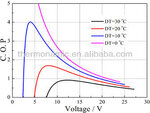T
treez
Guest
Hello,
We wish to do a Peltier cooler for a Laser diode.
The current will be up to 20 Amps, bidirectional, so we cannot use off-the-shelf switch mode peltier controllers.
Do you think our following method is the most lean?...
We will have two synchronous bucks either side of the peltier element. We will have a single control signal which feeds into both bucks. This control signal will increase the energy throughput of one buck whilst simultaneously decreasing the duty cycle of the other one (and vice versa). We will also use two LTC6101 current monitors as per page 29 of the following to get a current monitor signal which is unipolar but represents current flowing in either direction.
http://cds.linear.com/docs/en/application-note/an105fa.pdf
The error signal between demanded temperature and actual temperature will feed into the current error amplifier to control the peltier current accordingly, and thus control the temperature of the laser diode.
Do you agree that this is the best way forward?
We wish to do a Peltier cooler for a Laser diode.
The current will be up to 20 Amps, bidirectional, so we cannot use off-the-shelf switch mode peltier controllers.
Do you think our following method is the most lean?...
We will have two synchronous bucks either side of the peltier element. We will have a single control signal which feeds into both bucks. This control signal will increase the energy throughput of one buck whilst simultaneously decreasing the duty cycle of the other one (and vice versa). We will also use two LTC6101 current monitors as per page 29 of the following to get a current monitor signal which is unipolar but represents current flowing in either direction.
http://cds.linear.com/docs/en/application-note/an105fa.pdf
The error signal between demanded temperature and actual temperature will feed into the current error amplifier to control the peltier current accordingly, and thus control the temperature of the laser diode.
Do you agree that this is the best way forward?
